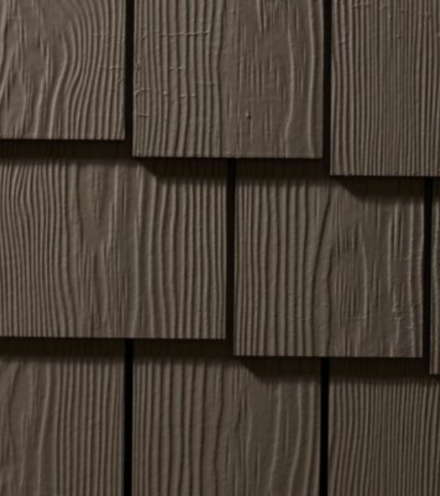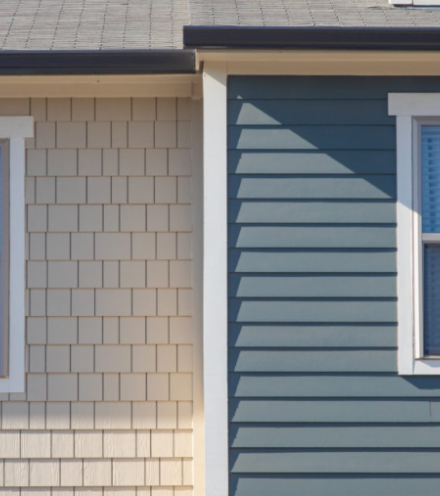There are many components that make up the exterior of your home, but none are as prominent or as important as the exterior siding. Siding is your home’s first line of defense against the elements, and it’s also what gives your home its finished appearance and curb appeal.
There are many types of siding on the market today, each with its own positive and negative attributes and characteristics that may or may not make it the right fit for your home. Because there are so many choices, it can be hard to determine exactly which option is best.
Fortunately, we’re here to help. That’s why we decided to create this comprehensive list of the different types of house siding, including advantages, disadvantages, and costs for each one. Let’s dive in!
1. Stucco
Stucco is a unique siding material made from a blend of aggregates, including cement and sand. It’s applied in layers and can be smoothed or worked into a texture, depending on the amount and texture of aggregate used.
Advantages
Stucco has a unique appearance that complements many types of architecture. It’s also fairly durable and resists most moderate knocks and impacts, as well as heat and cold. It can also be painted in a variety of colors which makes it a versatile design option. In hot climates, stucco tends to reflect heat off the home which keeps the interior cooler.
Disadvantages
While stucco holds up well to normal wear and tear, it can become damaged by water, especially over time. Stucco will eventually become soggy and develop some signs of failure. When this happens, you have no choice but to replace the damaged areas, which can be relatively expensive and frustrating. Plus, it’s difficult to match the style, texture, and color, so you will need to repaint the entire structure to blend it in.
Beyond that, stucco doesn’t work well on every type of home. If you live in a home that looks better with traditional lap siding, stucco won’t work for you.
Cost
Stucco typically costs between $3 and $10 per square foot, including installation. Keep in mind that it usually has higher maintenance costs than some other materials and needs frequent touch-ups.
2. Wood
Wood is a very popular siding material, mostly because wood was one of the first types of siding used in homes. As a result, there are a lot of options available for style and appearance, which makes it super popular among homeowners.
Advantages
Wood is lightweight and fairly easy to install. It comes in many sizes and can be installed in several patterns, including shiplap, board-and-batten, traditional horizontal lap, and more.
From a design perspective, wood can be rustic or more contemporary and works on most architectural styles. There are also several different types of wood to choose from, so it can have a range of costs that will allow it to fit into most budgets.
Disadvantages
Wood is one of the most high-maintenance types of siding. It needs frequent repainting and could eventually develop problems with water (swelling, warping, cracking, or rotting).
Wood requires constant vigilance to make sure that inclement weather, water build-up, and insects don’t cause damage that can spread to other areas, so you need to stay on top of maintenance and repairs at all times. As a result, wood siding can be expensive to maintain.
Cost
Wood has a pretty big range of costs depending on the style and type of wood you choose. Prices start between $9 and $28 per square foot, including installation, which doesn’t include the cost to paint or stain the wood.
3. Brick
Brick has an instantly recognizable appearance that differs quite a bit from other siding types. While most homes today are clad in brick veneer rather than solid brick, the look has remained unchanged over time.
Advantages
Brick is an incredibly durable siding material. It’s unaffected by rain, snow, heat, cold, or impact. If it’s well-maintained, it can last centuries. It’s also flame retardant, insect-resistant, and fairly low-maintenance in its natural state. It doesn’t require regular painting or regular upkeep.
Disadvantages
Brick, even brick veneer, can be very expensive to install and repair. While it is durable, brick sometimes needs the mortar removed and replaced, which can be expensive.
Brick doesn’t need to be painted, but if you decide you don’t like the color and paint it, it will require just as much maintenance as wood, and it’s nearly impossible to revert to its original color later on.
Cost
Brick has a wide range of costs depending on the type, color, and thickness of the material. You can pay anywhere from $9 to $30 per square foot for brick siding, including installation. Brick veneer is a cheaper alternative to solid brick siding.
4. Stone Veneer
Stone veneer is a popular material for accents and occasionally for the entire exterior of the home. This material was once made from stone, but today, it’s actually made from a material similar to fiber cement that is made to look like stone rather than wood.
Advantages
Compared to natural stone, stone veneer siding is lighter, easier to install, and has much less variation from piece to piece or within one piece. If you choose this option, you can get better control over the appearance. It’s also better controlled for size and shape, so it’s less expensive than natural stone.
Disadvantages
The biggest disadvantage to stone veneer siding is that it’s difficult to install properly. The pieces don’t overlap like standard siding, so it’s easy for moisture and water to find their way behind the veneer and cause problems on the walls behind them. If this happens and you want to fix the problem, the veneer must be completely removed, which is very expensive.
Cost
Stone veneer can range in cost depending on how skilled the installer is and the size of the veneer. Expect costs to be between $11 - $18 per square foot and between $13 and $22 per square foot for installation. The higher price tag makes this material better suited as an accent than as a complete home exterior.
5. Metal
Metal siding is one of the oldest types of siding available today. It was first introduced as an alternative to wood and can be made of several materials, including steel and aluminum. There are also many ways to install it.
Advantages
Metal siding is super durable and resistant to moisture, insects, and flame. It comes in many styles, so it’s perfect for traditional, rustic, and contemporary homes. Plus, many of the styles are fairly low maintenance, so your siding can last a long time without needing much care. It’s also resistant to weather conditions such as heat or cold, so it works in all climates.
Disadvantages
Not all metal sidings are created equal. While one may be low-maintenance and long-lasting, another can dent easily or rust over time. Some types of metal siding also fade when painted which leaves a chalky residue that can stain your clothing. When the metal gets chalky, the only remedy is to repaint the entire surface.
Cost
Because there are several types of metal siding, there is a wide range of costs. In the market, you’ll find metal siding between $7 to $16 per square foot installed for steel siding or $6 to $10 per square foot installed for aluminum siding.
6. Vinyl
Vinyl siding is a synthetic material popular for its versatility, durability, and ease of maintenance. Made primarily from PVC (polyvinyl chloride), it mimics the appearance of traditional wood siding but without the high maintenance.
Advantages
Vinyl siding offers several benefits that make it a popular choice among homeowners. Firstly, it is highly durable and resistant to moisture, so it doesn’t rot, warp, or require frequent repainting like wood siding.
Its color is baked into the material, which makes it less likely to fade, peel, or chip, which adds to its low-maintenance appeal. It’s also available in various colors, styles, and textures for extensive customization to suit any architectural style.
Disadvantages
That said, vinyl siding is not without its drawbacks. While it is durable, it can be highly susceptible to damage from severe weather conditions such as hail or very high winds. Although newer, higher-quality vinyl siding options have improved their ability to retain color, cheaper options may fade over time, particularly in areas exposed to intense sunlight or high heat.
Cost
Vinyl siding is known for its cost-effectiveness by offering a good balance of price and performance. The cost of vinyl siding installation varies depending on the quality of the material, the complexity of the installation, and geographical location. It generally ranges from $3 to $12 per square foot.
7. Fiber Cement
Fiber cement siding is made from a mixture of sand, silica, cellulose fiber, and Portland cement. It can be installed in several ways and mimic the look of wood siding, which means you get the benefits of wood without any of the drawbacks.
Advantages
Fiber cement is incredibly durable and resists impacts, moisture damage, insect activity, and fire. It comes in architectural panels, lap siding, board-and-batten siding, cedar-look shingles, and decorative shingles, so it’s possible to easily match nearly any architectural style, from traditional to contemporary.
Plus, fiber cement comes in a wide range of colors, with a finish that resists peeling or chipping for 10 years or more. It’s also relatively low-maintenance once installed, with lower lifetime costs, which is a win-win for you!
Disadvantages
No material is perfect, and fiber cement does have a couple of minor drawbacks. It’s very heavy, so installation may require more than one person. It also needs to be cut in a way that helps contain the dust since it contains silica and produces a moderate amount of dust.
Cost
Like other siding types, fiber cement has a range of costs depending on shape, size, and color. You can expect to pay between $8 and $12 a square foot, including installation.
The Best Choice - Fiber Cement
Of the siding options we discussed, there’s no doubt that fiber cement is the only truly low-maintenance material that gives you a variety of choices in terms of style and appearance. It’s also less expensive than other low-maintenance materials like brick and doesn’t have high ongoing maintenance costs like stucco or wood.
If you’re considering new siding for your home, take a look at our fiber cement siding to find out more about how it can benefit your exterior, or contact us today to learn more!



